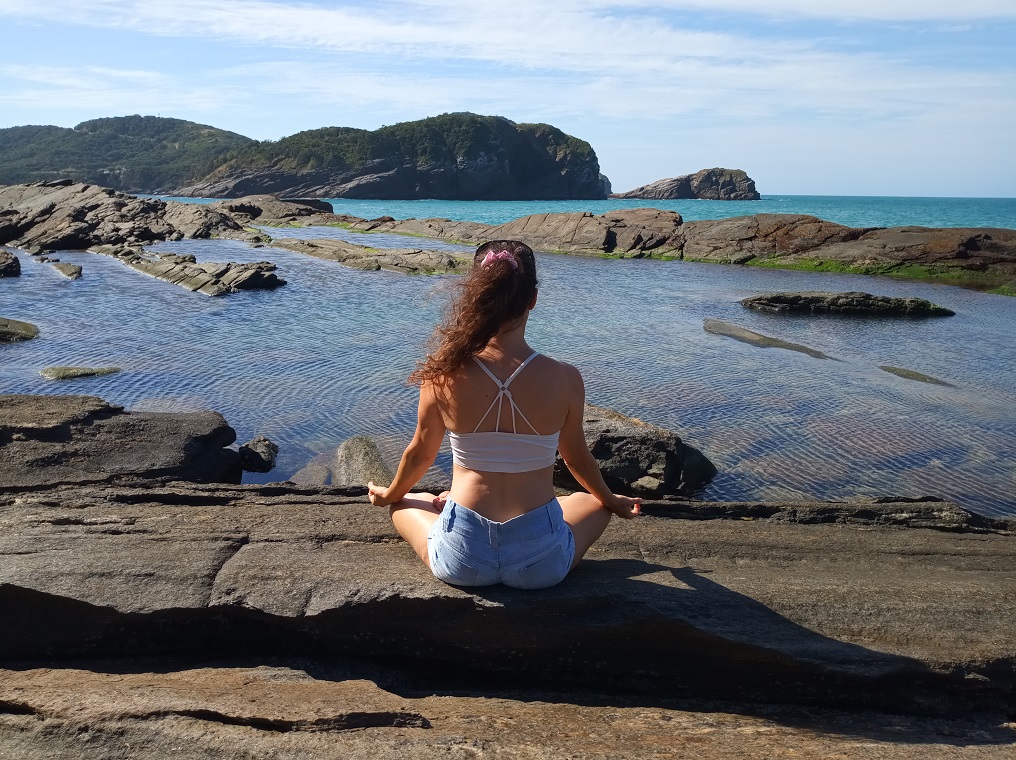Samyama is the group formed by Dhárana (concentration), Dhyána (meditation), and Samádhi (enlightenment or hyperconsciousness), each stage being the deepening of the previous one.
Samyama is a triple technique where each practitioner can reach a different (or deeper) level through the same technique.
In the first stage Dhárana (concentration) a focus of concentration is used. A focus where to keep the attention. A focus that allows the mind to concentrate and cease dispersion.
This focus can be an image, a sound, a sensation, etc..
There are people who can focus more or less easily. For those who have more difficulty, guided meditations with little stories and development of sensations are recommended. That way the mind is not alone without knowing where to go, thus preventing dispersion. The instructor brings the practitioner’s attention over and over to the exercise, draws attention so it does not travel and disperse.
The best conditions for concentration are: to practice in a quiet space, a comfortable place (where you feel comfortable), comfortable posture (it is advisable to practice asanas before), appropriate clothing (do not meditate with the same clothes as the work hours for example), practice regularly at the same time, make the meditation place a special place (which will induce surrender and introspection every time you sit there).
Buuuuttt the conditions are not always the right ones and this should not be a problem. That is why pratyahara (abstraction and retraction of the senses) must also be trained before Samyama.
Meditation practice is not for those who have all the easy conditions, it is for everyone.
And precisely those who do not have the best conditions are the ones who most need the practice of meditation.
So don’t worry if you don’t get any of these recommended conditions: sit down when you can, wherever you go and do your practice.
You will always have results, even when you practice without being able to concentrate 5 seconds in a row. For the mind must be trained, as the body is trained . It will not answer your concentration call on the same day, it needs practice, it needs to train. Until one day she concentrates!
And … I’m sorry for the sincerity … until another day there’s no way to concentrate and it seems that everything goes back.
O caminho tem seu altos e baixos, mas sempre de forma escalonada para cima. Sempre que sentar e praticar estará um passo mais perto da real meditação.
Why do I speak “real meditation”? because so far we have only trained the mind to focus and concentrate: Dhárana.
As long as the mind is wavering you are “practicing meditation” and not meditating.
Only when you can maintain this concentration will you be meditating ( Dhyána).
But don’t get discouraged because the path, whether short or long, is nice.
The recommended practice time is at least 20 minutes, up to 1 hour.
But in the beginning it is difficult to maintain concentration 20 seconds … imagine 20 minutes!
So go without haste … the practices can be short.
With short practices you will experience meditation faster, you can experience the benefits of meditation for yourself.
Wanting to meditate 20 or 60 minutes in the beginning can be very frustrating. Especially for those who are agitated, dispersed or experiencing a difficult situation.
However a short practice will be lighter, bringing comfort to your mind instead of pressure or frustration.
The extent of the practice will be determined by yourself. Don’t look for magic formulas. If today the practice of 3 minutes was good, tomorrow do 4 … don’t want to speed up the process, give yourself time.
And if you were practicing 10 minutes and today you can’t get more than 4, that’s ok. Do not insist. Don’t fight with your mind.
It is also not necessary to maintain concentration 1 hour. You have to respect your times and enjoy the practice. Give yourself the freedom to enjoy as much time as you want … 5 minutes, 1 hour … there’s no wrong.
The important thing is to calm the mind, to stop the oscillations. A clear and peaceful mind allows you to see life clearly. This is the goal of yoga.
“Yoga Chitta Vritti Nirodha” = “Yoga is the cease of mental fluctuations” (Yoga Sutras de Patañjali)
We said that for Dhárana (concentration) we train by focusing the mind on an image, a sound, or sensation, etc. And for Dhyána (meditation) how do we train?
For Dhyána you continue the same practice only that you will no longer have the interruptions of the mind. Brain waves change, but exercise is the same.
Until you no longer need any focus. At that point you take the focus off and the mind remains in the same state of full awareness, presence.
Dhyána is a deeper and higher stage that happens spontaneously.
Whoever speaks “I am very anxious”, “I am very agitated” , “I can’t stay still for 2 minutes” is the one who most needs to include Samyama in his life. If the mind keeps jumping there is no way to see clearly . If there are waves on the surface of the lake there is no way to see the bottom.
I could have said, “there is no way to see the beauty of the background”. But it will not always be beauty what is found … sorry again my sincerity.
When you observe clearly, you also see what was hidden. When you remove the filter you see the reality.
Yoga is the encounter with oneself. This meeting can be very nice sometimes, and some others not.
But the deeper states of meditation are always delicious, because there is an expansion of consciousness.


 WhatsApp
WhatsApp 

